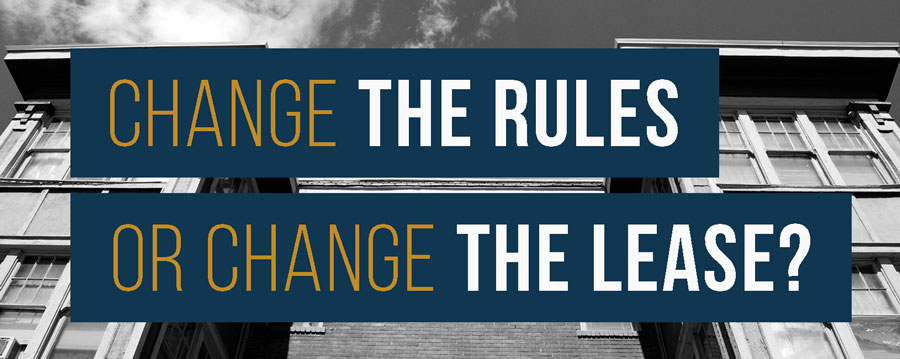This Month’s Video Topic:
How to get involved in legal issues that affect landlords.
Lead Article:
Change the rules or change the lease?
Quick tip:
What message are you sending your tenants? Are you sure?
Lead Article:

Change the rules or change the lease?
Several of our readers have posed the following question: “Should I change my rules or change the lease?”
Unfortunately, this is not an easy question to answer as it will depend on quite a number of variables – each of which requires consideration. Nonetheless, to get you started, let’s spend a little time discussing the generalities associated with making this decision.
FIRST, lease changes are not enforceable (either to an individual or to a household) unless someone has signed and agreed to those changes. With the original lease, you instituted a written, signed agreement with the resident. By law, you cannot change it unilaterally, which basically means, without their consent. Your lease is a contract to which you and your resident have consented. Your relationship is governed by that contract and you can’t change it – any more than the tenant can – unless both of you agree to that change.
Luckily, such is not necessarily the case when implementing rule changes within your community. State statute provides the landlord protection that allows you to make changes to your community rules without the consent of your residents. You will have to warn them of the pending change, but with proper notice, you can make the change of your own accord.
NOTE: The one – and I might add significant – caveat is that you cannot make lease changes under the guise that they are rule changes. If your rule changes are modifying the fundamental nature of the relationship established in the lease, there is a strong possibility that the changes will not be validated if challenged.
To illustrate this factor, let’s for simplicity sake, consider the following example: You attempt to add a community rule that says the building will be secured at 5:00PM when the management office closes. By implementing this rule, you are in reality, blocking your residents’ access to any units in that building after 5:00PM. While I know this rule change may seem absurd, it’s a simple example of how a community-wide rule, when implemented, can change the basic nature of your arrangement with your residents, making it easily challengeable.
SECOND rule of thumb, because a lease change requires consent, it may take quite some time to implement. Be prepared for the fact that you will likely have both the old lease and the new lease active simultaneously while you either obtain consent from each resident, or allow all current leases to expire – at which time you can offer them the new lease at renewal time.
Luckily, timing is not a factor with community rule changes. Once you’ve given the community notice of an upcoming rule change, along with the timeframe that they will be effective; your process is pretty much complete.
NOTE: This simplicity applies to market properties only. If you are dealing with subsidized properties, there are quite a number of other required steps you must complete prior to implementing a rule change, otherwise, you run great risk of significant liability.
LASTLY, changing your lease usually has a much bigger impact on your overall operations than a simple community rule change. Since the fundamental relationship you have with your residents is being altered, the immediate and further impact of such changes should be considered more thoroughly. After all, if you find you are unhappy with an implemented lease change, correcting the mistake will require a duplication of the same effort and time already displayed. Lease changes should not be taken lightly and should be completely evaluated before implementation. That’s not to say that community rule changes can be addressed with minimal attention, it’s just that the stakes are a little higher when making changes to your lease. Best to contact your landlord attorney if you’re unsure.
Quick Tip:
What message are you sending your tenants? Are you sure?
A few years back, the CTAA hosted Janine Driver, a body language expert, as its keynote speaker at its annual tradeshow. Janine shared with the crowd her knowledge about how we deliver messages to people that don’t necessarily depend on, or match, the words we are saying. We wrote back then (and revise here today), our thought on sending the proper, or rather the intended, message to your tenants.
Now, I won’t pretend to know what your message is – since I don’t live in your community. But, I will challenge you as to whether you are delivering it effectively. The reason I feel qualified to do that is because, as a landlord attorney, I often see management’s conduct with their residents falling out of step with their intended message. They simply do not DO what they SAY. While this is often just a mere hiccup in their operations, sometimes, it can really have a serious impact on the achievement of their overall goals.
Hopefully a quick, practical example will illustrate my point…
You, like all other landlords or property managers, want your residents to pay their rent in full and on time, without any effort on your part. You have the requirements for making these payments outlined in your lease, you likely cover these obligations in your lease signing ceremonies, and you have possibly even sent letters to the entire community reinforcing the rules – perhaps along with the consequences associated with noncompliance. Having done all this, you can rest assured that this message has been presented perfectly clearly. Or, can you? And, has it?
Do your actions regarding timely rent payment support that message – or dilute it? Do your collections efforts each month (whatever they might be) reinforce your expectations for prompt payments or do they contradict your goals? It is important that you find out. If you make reminder phone calls, are they telling your tenants that prompt payment is required, or are they telling your tenants that until you get a call from management, no need to worry about paying the rent?
The purpose of this tip is to encourage you to investigate the situation from a bird’s eye viewpoint. Evaluate your actions as much as your words. If you cannot determine whether you are sending a clear, singular message to your community, perhaps you need to reassess. Make sure that your actions support your words – or your words may be ignored, and typically, to your detriment.
